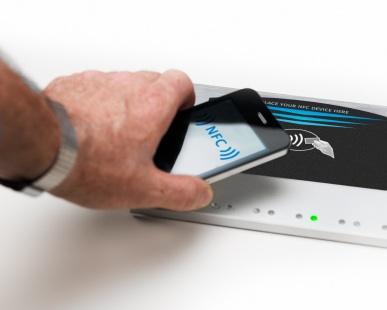 Much has been written about NFC or Near Field Communications. Indeed the technology itself has been in existence for nearly 10 years now in various applications. NFC is a class of communications within what is known as RFID (radio-frequency identification) and was designed to allow short-range two-way wireless data communications between devices. Cleverly, NFC is designed for use with passive devices – devices that do not require a power source or a battery to operate. This makes it an ideal technology for use in credit and debit cards for stored value cards and mass-transit applications where it replaces the requirement to swipe or insert the card into a reader.
Much has been written about NFC or Near Field Communications. Indeed the technology itself has been in existence for nearly 10 years now in various applications. NFC is a class of communications within what is known as RFID (radio-frequency identification) and was designed to allow short-range two-way wireless data communications between devices. Cleverly, NFC is designed for use with passive devices – devices that do not require a power source or a battery to operate. This makes it an ideal technology for use in credit and debit cards for stored value cards and mass-transit applications where it replaces the requirement to swipe or insert the card into a reader.
More recently, NFC technology has been incorporated in mobile phones where it is used for loyalty, redemption, access control and more interestingly for mobile payment applications.
There are however several major challenges in using NFC for mobile payments which is why many applications struggle for take-up.
Without even addressing the technical and security issues surrounding the suitability of NFC technology for mobile payments, there are bigger picture issues which come into play that effect adoption.
As with any new approach or solution to a problem be it technological or otherwise, for it to succeed and achieve scale, the most important fundamental principle is that it must ultimately solve a problem or address a specific need. This combination reflects the value of the solution and generally determines the level of adoption. Other factors that influence adoption to a lesser degree include the magnitude of the problem, usability factors, and whether the solution is forced or mandated. Herein lies that famous and horribly overused term the value proposition.
I mention these basic principles as they need to be addressed when analysing NFC in retail mobile payment applications.
The very short-range nature of NFC means it can only be used as a proximity payment solution – that is that the transaction must occur at the physical point of purchase. NFC was developed with this scenario in mind and it is no surprise therefore that this is why NFC works very well in both card payment and mass-transit applications. In this scenario the primary value proposition is that the physical transaction process is faster than alternative methods such as paying with cash or coins.
When evaluating NFC in mobile payment applications, it is the overall value proposition to the consumer that is often overlooked.
As a proximity only based solution, NFC when used in mobile payment applications, is restricted to Point Of Sale transactions only. Integrating NFC with a mobile phone is therefore somewhat pointless as it neglects the mobile network capability of the device – it no longer becomes a mobile commerce but a fixed commerce POS solution. Indeed, to the consumer there is little benefit in using an NFC mobile payment service over an existing card payment method. In both scenarios, the transaction has to be initiated at the same physical point of purchase. Funds are also transacted out of the same payment instrument – the card account.
What then is the real benefit to the consumer? Is waving a mobile phone across an NFC reader really that much easier and desirable over waving my wallet or card over the same reader? Is seeing my on-screen balance after an NFC mobile payment really necessary? Would I even look or care? Most of us have enough money in our day-to-day transaction account to not need to know the account balance after every transaction – one of the core “benefits” promoted by NFC mobile payment solutions.
Furthermore, as Reed Peterson, head of the NFC initiative for the GSM Association recently admitted “To make a payment in a store with your phone, you need a lot of things to align. The phone needs to be properly equipped with NFC hardware and software; the store needs to have the proper equipment and training. The phone company needs to support the transaction, and banks and payment processors need to be in on it.” For the full article click here.
A major obstacle is ownership of the secure element of the NFC transaction ecosystem. The secure element is sort of like a safe inside the phone. Whoever controls access to it decides which cards, transit passes or other verified documents the phone can store. Each stakeholder believes that they are best positioned to do this because it symbolises ownership of the customer.
Control of the secure element is a crucial battleground for NFC. The GSMA, which is dominated by mobile phone carriers, advocates putting the secure element not in the phone itself, but in the subscriber identity module, or SIM card, which plugs into the phone to identify the user and supply a phone number to the network. SIM cards are issued and controlled by the carriers who would like to be the ones in control of the secure element. Not surprisingly the card scheme operators believe that they should control the secure element due to their experience with payments.
Getting NFC to work in mobile payments requires bank A to work with mobile network B using an NFC capable mobile handset manufactured by C. In today’s environment where the consumer is used to having total power of choice, mandating these combinations to get NFC to work are not consistent with consumers expectations. Sacrificing freedom of choice is a lot to ask consumers to give up especially when the overall value the service provides is low.
Given a choice, and all other things being equal, consumers will naturally gravitate toward what they are familiar with. Creating behavioral change particularly when it comes to payments, must provide the consumer with a clear benefit over what they are used to otherwise they simply won’t use it – particularly when they are already using a solution that works. History and human nature tells us that unless there is some demonstrable reason to change created by a perception of value, people will naturally gravitate to what they already familiar with….
Maybe in the end it will all be way too hard, suggesting perhaps that NFC is Not For (mobile) Commerce?
Harold Dimpel is the founder and CEO of mHITs Limited an Australian based developer and operator of mobile payment services. In Australia, mHITs (pronounced Em-HITS) operates the mHITs SMS payment service that allows consumers to send and receive payments by SMS text message. mHITs is also working in emerging markets in the design, deployment and operation of mobile payment solutions for the so called “unbanked” (people who do not have access to traditional banking services). For more details visit www.mhitslimited.com.


Follow Us!